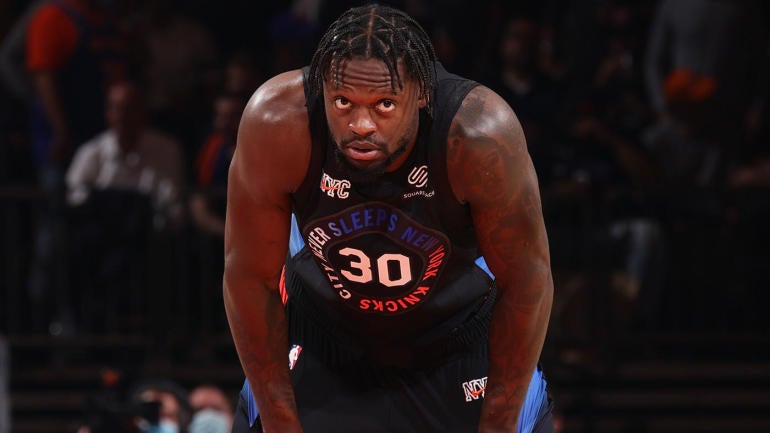
The New York Knicks managed to even up their first-round playoff series against the Atlanta Hawks on Wednesday night, but they're going to need a stronger performance from their lone All-Star, Julius Randle, if they're going to advance to the conference semifinals for just the second time in 20 years. Randle has scored 30 total points in the first two games of the series after averaging 24 per game during the regular season, going 11 for 39 (28 percent) from the field and 4 of 13 on 3-point attempts.
So how do the Knicks get their potential All-NBA forward going? They need to borrow a common phrase from real estate, which is especially salient in Manhattan: Location, location, location.
Throughout the first two games, Randle has consistently gone to work in isolations from the wing. His defender overplays him toward the middle, forcing him baseline into the waiting arms of the Hawks center (usually Clint Capela), who has little-to-no regard for Nerlens Noel or Taj Gibson in the dunker spot. This takes away any hope of Randle getting into the paint, instead forcing him into a contested mid-range pull-up.
This is clearly by design for Nate McMillan and the Atlanta defense. As you can see in the shot chart below via Positive Residual, Randle has been atrocious on his baseline jumpers in Games 1 and 2.
But if you look at his regular-season shot chart, Randle performed similarly poorly all year long on those baseline midrange shots. The Hawks are baiting him, and for the most part it's worked.
Well, if they're essentially double-teaming Randle with Capela, someone should be open, right? Yes and no. The Hawks are mostly sagging their weakside wing defender all the way into the paint, and relying on their ability to recover (and some of the Knicks' unintimidating 3-point shooters) to save them. Here's a play that perfectly illustrates Atlanta's game plan:
1. Hawks forward De'Andre Hunter sags all the way to the strong side of the key to defend Noel in the dunker spot, leaving RJ Barrett wide open in the weakside corner:
2. Randle reads Capela waiting to double, sees Barrett open in the corner and hits him with a cross-court pass. The Hawks will live with Barrett's 3-point attempt, but Hunter is so fast and long that he gets all the way to the corner for the contest in a split-second, forcing Barrett to drive baseline, where he knows he has help waiting:
3. Denied access to the rim, Barrett kicks out to Randle, who is run off the 3-point line and -- once again -- forced into a midrange baseline jumper by John Collins. Randle's open, but these are the shots the Hawks are willing to live with:
Tom Thibodeau and the Knicks clearly noticed how the defense was playing Randle and adjusted -- particularly in the second half of Game 2 -- by getting Randle the ball in the middle of the floor, either through a pick-and-roll or by Randle pinning his defender around the free throw line. The pick-and-rolls allowed Randle to get downhill heading toward the basket, where he can do so much damage with his size and strength.
If he's kept out of the lane, at least his mid-range jumpers are in rhythm, and coming from spots from which he shoots a much higher percentage.
As a spectator it's easy to say, "just get Randle the ball in the middle of the floor," but obviously it's not that simple -- especially with the inevitable adjustments McMillan and the Hawks will make. But if Randle is forced to operate from the wing, one thing he can do is avoid going baseline into the waiting help. Watch here as he fakes baseline, but instead goes to his right. Getting to the middle of the floor shortens the pass to the open 3-point shooter, giving the Hawks defenders less time to recover. Immanuel Quickley misses the 3-pointer badly, but it was a clean, open look for a normally reliable shooter:
As you can see, Randle essentially draws all five defenders, leaving Quickley, Alec Burks and Derrick Rose open from behind the arc.
Randle scored 13 points and went 5 for 10 from the field (nearly half of his made field goals for the entire series) in the second half of Game 2, doing the majority of his damage from the middle of the floor. After the win, Randle noted how part of his adjustment involved attacking from different spots.
"Caught the ball in a little bit different areas," Randle said. "It was a little adjustment just trying to figure it out a little bit. But I still gotta be a lot better."
Expect Thibodeau to run more pick-and-roll with Randle as the ball-handler in Game 3, and to set him up for isolations around the free throw line rather than the wing. If Randle can avoid falling into the Hawks' trap of going baseline, he could start to look more like the player Knicks fans grew accustomed to seeing during his breakout regular season, and give New York a much better shot at putting the Hawks away.
"make" - Google News
May 28, 2021 at 09:45AM
https://ift.tt/3yJiudJ
Knicks vs. Hawks: One simple adjustment New York can make to help Julius Randle break out of funk - CBS Sports
"make" - Google News
https://ift.tt/2WG7dIG
https://ift.tt/2z10xgv
Bagikan Berita Ini














0 Response to "Knicks vs. Hawks: One simple adjustment New York can make to help Julius Randle break out of funk - CBS Sports"
Post a Comment